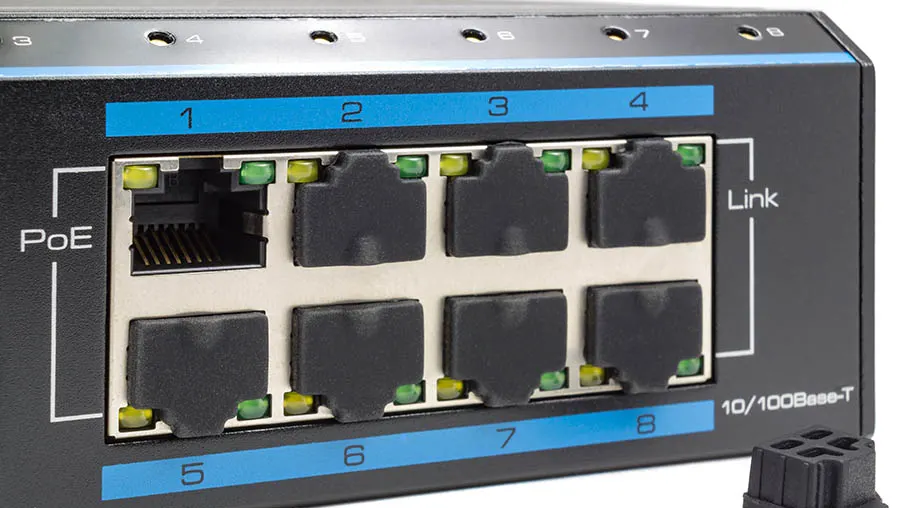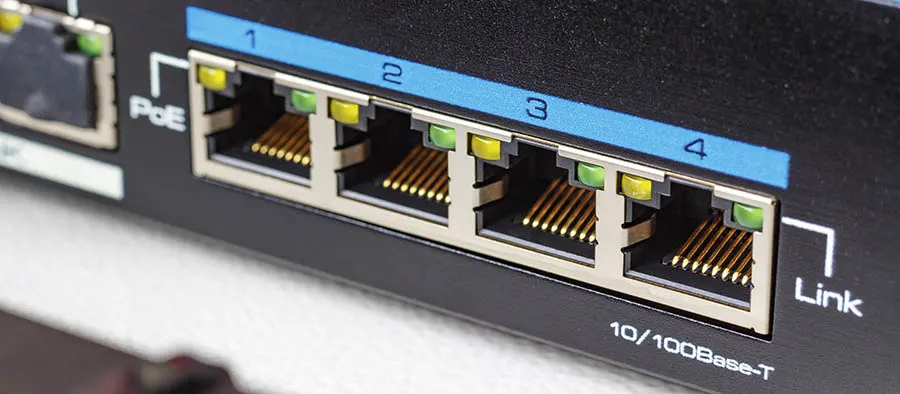If you’re thinking about using a voice over IP phone system or considering adding security cameras to your home or business, you might consider using a PoE switch to provide both internet communication and power to those devices.
A PoE (or Power over Ethernet) switch, is a tool that supplies a network connection and electrical power to each connected device. It allows many network-enhanced devices to work without the need for a separate power cable.
It’s easy to add PoE switches to your current network or to replace your old, non-PoE switches with PoE switches. They work just like traditional network switches, with one important feature: electricity. For the majority of applications, they are compatible with non-PoE devices and should work fine if you’re upgrading gradually or if you want to use PoE for only a few of the devices on your network.
What Makes a Switch a PoE Switch?

Basically, an ethernet switch, such as the NETGEAR 16-port (on Amazon), allows many devices of your LAN (Local Area Network) to connect and communicate with each other. Most homes that have access to the internet often do so via a router (often wireless), and only use one IP address. When you’re upgrading, keep in mind that for many homes, the modem and router are bundled together in one convenient device.
Don’t replace that one device with a PoE switch (or any switch); because you’ll lose the modem, and the results may be total loss of your network! Switches are a bit like souped-up routers and do not usually include a modem. They’re more commonly found in offices or in locations where numerous devices need to make network connections, or if using more than one IP address.
However, there are several scaled-down PoE switches available that are well suited for home-sized networks like NETGEAR’s 8-port switch (on Amazon). A PoE switch works just like a regular switch, except that it delivers both internet connectivity and power through the same cable. Conveniently, PoE switches provide this via the familiar Cat5, Cat5e, and Cat6 ethernet cables.
Ethernet cables consist of 4 pairs of color-coded wires. PoE works because only 2 of those pairs of wires are used to send and receive data. For PoE, the other two pairs carry a positive and a negative/ground electrical signal, rated at 24 to 48 volts, which PoE enabled devices can utilize for power. This allows the information to-and-from the network to travel along the cable without interference from the transmitted electricity.
Advantages and Disadvantages of PoE Switches

One main advantage of PoE switches is the reduction in installation costs. PoE switches eliminate the need for power cables, and can therefore cut the number of cable runs in half. It’s also easy to imagine that, as more kinds of PoE devices become more available and popular, they’ll become increasingly easy to use. “Plug-and-Play” for networked devices!
For now, PoE switches are well-suited for use with VoIP phone and security camera systems. Using a PoE switch, it’s easier to deliver an internet connection and power via one cable run, eliminating the need for any external power supplies, and simplifying their installation. There are also PoE switches on the market that are made specifically for home security systems, which offer easy setup and ports for multiple cameras, modems, and video servers.
If you want to power a device with a PoE switch isn’t PoE capable, you can still use the transmitted electrical signal and power the device with PoE via a PoE Injector, in fact, we have a whole guide on that. An Injector adds power to a network cable, then provides both to the device via one cable. Make sure when using this technique that the voltage coming out of the Injector is sufficient for the device it needs to power.
There are some important limiting factors to consider when installing a PoE system. PoE switches generally support cable runs of 100 meters for a 48V power supply, or about 50 meters for a 24V supply. However, some PoE switches have a total wattage limit, so check to make sure your devices are not drawing more power than the PoE switch can handle, moreover, we have more information in our guide that you should understand. Do your research using some of our other guides like this one before buying, because some PoE switches only supply power for a few ports.
When You Might Want a Normal Switch
When you don’t need power sent to your switch-connected device, no problem; a PoE switch should work just like a regular switch. However, check with the device manufacturer to ensure this is the case; some devices may not enjoy the unwelcome electrical boost. If you only have a single device that you’d like to use PoE with but don’t want to change your switch, you can use a tool called an Injector.
A described above, an Injector adds PoE capability to one individual cable run from the switch. There are many Injectors on the market. Another advantage of using an Injector is that you can customize the voltage for the device being powered, and Injectors are relatively inexpensive.
